When I heard a couple months ago that The Queen’s Gallery at Buckingham Palace would be hosting an exhibit by the Royal Collection Trust titled In Fine Style: The Art of Tudor and Stuart Fashion this summer (May – October, 2013), I knew I’d have to get my hands on the exhibit catalog.
So I did!
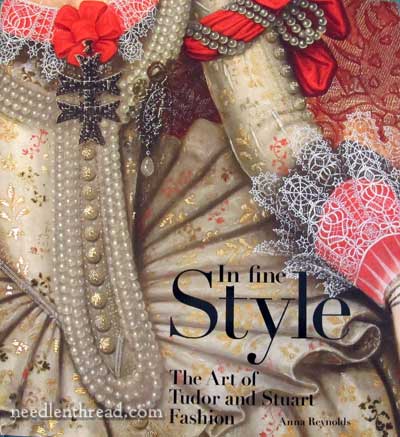
If you’re a fan of historical textiles, if you love the combination of textile history and social history, if you love art – you will love this catalog. It is a massive, beautiful book by Anna Reynolds, Curator of Paintings at the Royal Collection Trust. And while it is filled with photos that will delight the eye and mesmerize the brain, it is also jam-packed with thoroughly readable history.
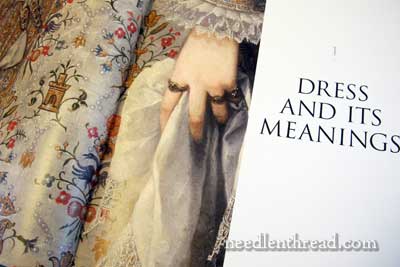
The book and exhibition explore the finery of Tudor and Stuart dress, through the study of portraiture juxtaposed with preserved textiles.
In Fine Style is divided into eight main parts: Dress and Its Meanings; Dressing Women; Dressing Men; Dressing Children; Painting Dress; Fashion Across the Borders; Painted for Battle and the Hunt; and Playing a Part (dress in entertainment).
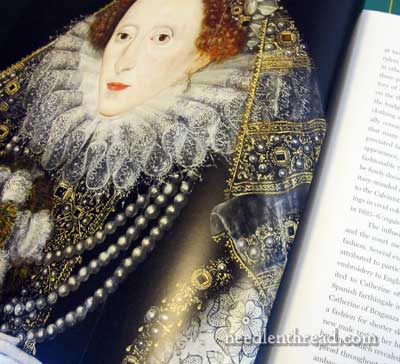
Using social commentaries, documented records, and diaries, personal notes and communications from the era, the text unfolds in amazing detail an historical era that was sumptuous, fascinating, and full of intrigue.
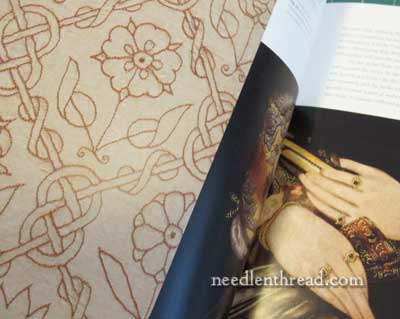
The whole focus of the book is, of course, dress, and most especially the dress of the rich and famous.
While sitting about in our cotton knits and light layers of clothing, it is almost impossible to imagine living in the dress of the Tudor & Stuart eras – the layers, the ruffs, the tights, the heavy fabrics, the embroidery encrusted jackets, the shoes, the gloves….. not to mention everything underneath all of it!
Dress was a statement of wealth and status. (In that regard, have we really changed that much?)
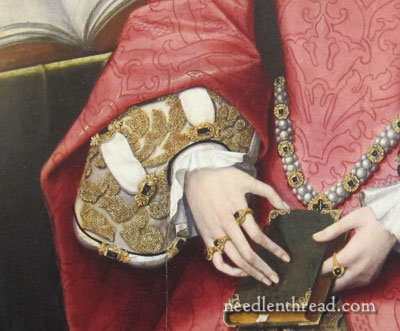
I love the author’s opening statement at the beginning of “Dress and Its Meaning”: Even when it conceals the body, clothing is revealing.
She goes on:
For the sixteenth- or seventeenth-century audience, clothing could reveal information about a wearer’s social position, wealth, religion, nationality, marital status, fashionability and so on. Today, given our inevitably incomplete knowledge of the social context in which the paintings were produced and viewed, some of the subtle nuances have been lost. Traditionally, the importance of clothing in portraiture to the modern viewer or researcher has usually been as a tool for dating a portrait. Yet the clothing worn, together with the manner in which it has been painted by the artist, can reveal so much more – it can help identify a sitter, artist or provenance, and more broadly can provide information about sixteenth- and seventeenth-century society and attitudes.
And that, in a nutshell, gives us a direction for the book. It is, on the whole, a social exploration of the times, using the portraits (and actual textile samples and what we know about them) to unlock a broader view of the era.
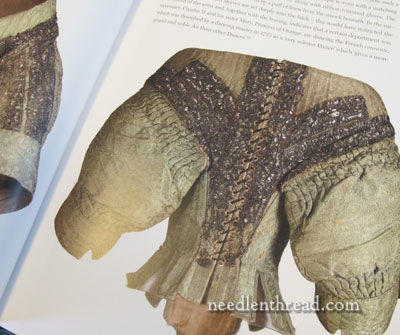
So, what will you find in the book?
Image-wise, you’ll find portraiture galore – with many close-ups that reveal details you may very well miss while meandering through a museum – and a good smattering of textiles and close-ups of textiles, especially those which tie in somehow to the portraits discussed because of style, types of embellishment, owner, maker, and so forth.
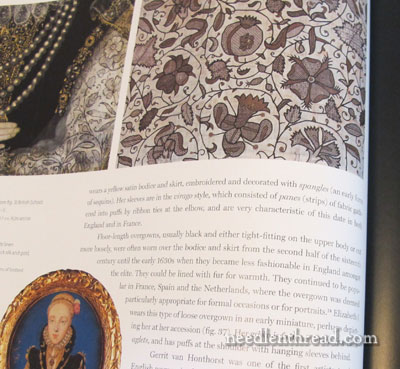
I especially love the juxtaposing of the textiles in the portraits with examples of real textiles. What incredible pains these master artists went to, to faithfully produce in their portraits the tiniest details of finery!
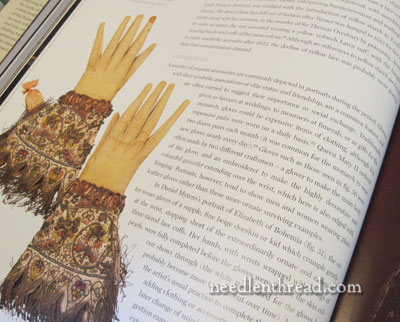
I also love the explanations of different elements of clothing, when they would have been worn, why they are shown in portraits (or not shown), how much they would have cost to make, who would have made them and how they were made. These details bring the era to life!
From gloves…
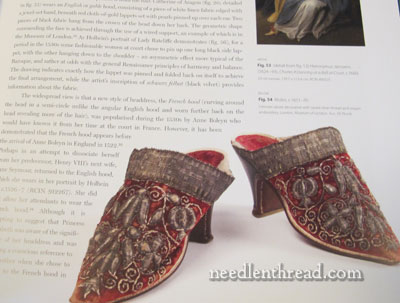
…to shoes, we learn about each element of showy fashion and why those elements were important to their wearers. It wasn’t just the blissfully simple matter of keeping the feet dry or the hands warm!
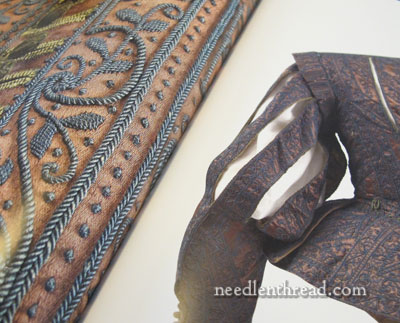
For the embroiderer, it is the close-up details of textiles that will certainly enchant, whether they be the real thing…
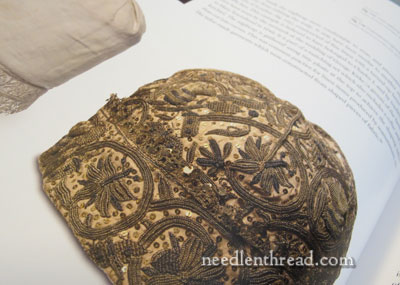
…like the doublet or the night cap…
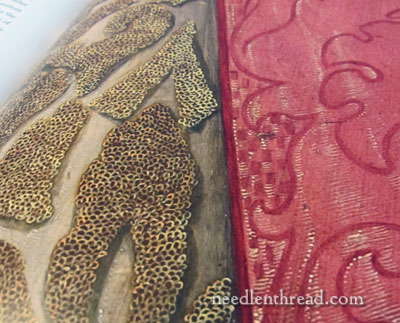
or the painted thing, like the velvet and goldwork…
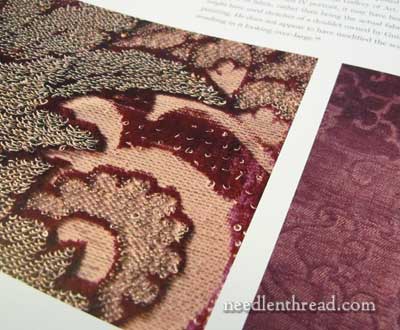
…next to the real velvet and goldwork.
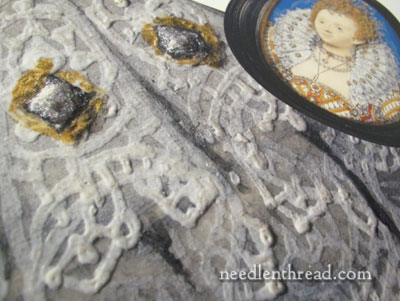
For me – so far – the most fascinating section of the book is on painting dress. I’ve only read about a quarter of the book so far, but this section absorbed me and I gobbled it up. I’m always in awe of the talent and techniques of artists! For me, this part of the book alone was worth the price of the whole.
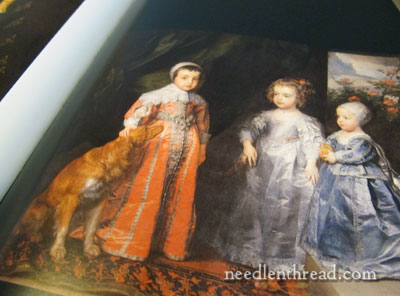
The other section that grabbed my attention and that I read straight through was that on painting children. Dressed like miniature versions of their parents, the children in the portraits are encrusted with layers of elaborate clothing.
The author notes that the children were a reflection of status as well. One example that comes to mind – the dressing of a child in an apron made from a costly piece of lace made a very clear statement about mommy and daddy and their wealth and social standing.
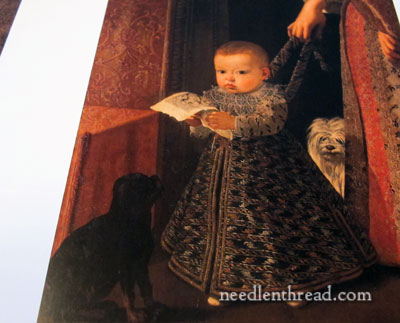
Oh golly. Thank goodness for the onesie!
In Fine Style: The Art of Tudor and Stuart Fashion is a gorgeous book. It provokes thought, it engages the imagination, it satisfies the curiosity. If you like this kind of stuff, you’ll love the book!
It does not make the best bedside reading, admittedly. As I mentioned above, the book is huge. It’s a coffee-table book your guests will love to browse through, and it’s a readable book that you’ll enjoy better while sitting at a table. It’s a hefty thing!
Where to Find It
You can find In Fine Style available through the following book affiliates:
In the US, you can find In Fine Style available here, through Amazon.
Worldwide with free shipping, In Fine Style is available here, through Book Depository.







Thank you so much for this review. I love this type of book. Without your blog, it would have taken me ages before I would find out about this book.
I want to know what the diapers were like! (as a cloth diaper user) and yikes when they soiled the diaper through onto THAT outfit!
Diaper-disaster? I was thinking that as well. I know diaper clad boys did not wear pants like their fathers, but still…. Yipes.
OMG!!! got to have this book! i love the elizabethan era in general and Elizabeth herself has always fascinated me. I really, really can’t afford this book but i really, really have to get it!!!
Mary, did you ever announce the winner of the other historical book you were giving away?
sharyn g
Hi, Sharyn – Yes, I did – that was last Monday: https://needlenthread.wpengine.com/2013/05/twixt-art-nature-book-winner.html
Mary,
Thank you for sharing this book review with us. I am fascinated by everything “tudor” and have since purchased the book. Amazon.co.uk suggests the book has been out since April but appreciate it takes longer for it to become available overseas. I went to Hardwick Hall a couple of years ago and was lucky to see some of Bess of Hardwick and the Mary Queen of Scots embroidery work – it was fascinating and considering how old they are, some of the pieces were in amazing condition. So you may enjoy the National Trust book titled “The Embroideries of Hardwick Hall: A Catalogue” – it too is a chunk of book but fascinating and allows you to see the collection as they obviously can’t display the entire collection at any one time.
Best wishes,
Nina Broderick
This is a magnificent book! Thank you for the detailed review! I’ve put it on reserve with Amazon and can’t wait for it to come. This kind of study in clothing/fashion/costume is what thrills me to the bone! Hugs to you!
Oh, how I want this book!
Thinking about how to change diapers when the kids are wearing all of that is rather frightening……..
Dear Mary
How fascinating, I really like history and I am interested in the Tudor & Stuart era, from the photos it looks an extremely detailed book. The skill of the embroiders of that period is mind blogging, such detailed work they certainly were artists in embroidery. I love the goldwork on the painting of Elizabeth I as a pricess beautiful,the gloves of the period are exquisite.I love the photo of those beautiful shoes and the doublet imagine the work that went into that one item just to wear at night. I didn’t know about the exhibition I must visit the Queen’s Gallery and exhibition. Thanks Mary for sharing this with us.
Regards Anita Simmance
Ohh, OHh, OHH! (Apparently it’s rude to use capitals in social media, but…THIS book…I’ll just have to BE RUDE…) And it’s my birthday today too, or at least it was a couple of hours ago, down here, 25th, AND our wedding anniversary! Mmm, birthday $$. YES!
Oh, by the way, G’day Mary. Thanks for the scrumptious review. Cheers, Kath.
I just had to add this lovely book to my wish list. Thank you Mary for such an interesting review.
Karole in Texas
Oh, Mary! You are so bad for my pocketbook!! I just pre-ordered “In Fine Style” on Amazon. I love this time period and the clothing is fascinating.
I am currently reading a book about John Quincy Adams and his wife, Louisa. It is about when he and she traveled to Russia in the early 1800s to try to establish US/Russian trade with Emperor Alexander. I mention it because both Adams’ had traveled in Europe prior to this time and knew of the elaborate dress worn by royalty. However, the Russian court completely overwhelmed them with the extravagance. Of course, they, as representatives of the new country of the United States of America had to find a way, with their very limited budget, to dress appropriately. Mr. Adams was frugal and conservative and it was always a struggle to find balance. How you dressed meant EVERYTHING! The book is called “American Phoenix” and is by Jane Hampton Cook. Interesting read and very enlightening regarding US history.
Blessings to you. Thank you for your wonderful work for all of us needleworkers!
Connie
That does look a wonderful exhibition. I might even try to go but would have to find something to combine it with to justify the 6hr train trip!! I love this period of history and am an occasional embroderier but its always been kits so I am finding your blog fascinating
I believe they used rags for diapers and other personal hygiene items. Of course, the more wealthy people probably used better rags than the poor peasants and had household staff to do the laundry.
Thanks Mary for sharing this. I have been on a Tudor and English history kick since we have traced my dad’s family (Owen) back to Spilsby, Lincolnshire, UK. My great great great grandmother was a Spencer before marrying into the Owen family. I like to dream about being related to the late Princess Diana.
Yes, but if it leaks, and plastic diaper covers had not been invented yet, who wants to clean up (if it is possible) an elaborate gold embroidered kids outfit? Or worse, embroider one and then watch the kid get bleepity-bleep all over it.
I just want to say first, that this book looks amazing, and reading your blog makes me wish I embroidered. But I HAVE to say that the major thing I took from today’s post is the last picture with the toddler leash. I love that! I laughed a little too hard at the thought of royalty being paraded around by a leash in the way we take our children to the mall! Thank you for the giggle, and the interesting read.
Jessi
la magia del bordado…que delicadesa …no puedo comprar el libro pero nunca habia pensado en tanta ropa bordada
gracias mary
I would love to read this book! Alas, the only way I’ll ever see it is through a library (if then) but thank you so much for your tantalizing review of it. I will definitely keep it in mind…
Oh Mary, you’ve done it again. First it was ‘Twixt Art and Nature’ which I just had to have and now this one, which I also just have to have. I ordered it and it arrived in double quick time. Like you I find the part on painting all these fabrics fascinating, especially as I used to do a lot of painting and for 10 years I was a docent at the National Gallery of Australia. The whole book is absolutely gorgeous; the producers have well and truly done their subject justice.
The amount of money that was spent on clothing for some of these people would finance an entire small country today. We think that the current Royal family are extravagant when in fact they are probably extremely frugal, compared with their forbears.
sigh….i finally rearranged my budget and ordered the book, Mary. now i can’t wait to get my hot little hands on it….can’t wait.
sharyn
Well, Mary, I dragged the book (£29.99 in the gift shop) back from the Queen’s Gallery today. The Exhibit was Spectacular! The paintings and textiles were thoughtfully selected, and well-displayed. Not overwhelming or crammed together like I’ve seen in other exhibits. The multi-media individual guide with head phones was an added plus. I went today, a Thursday, at about 3 pm. No crowds whatsoever. The embroidery is out of this world, particularly the floral pieces. The commentator could not explain how this work could have been done without artificial light or magnification. Boggles the mind. She also stated that most of the embroidered were men! Hmmm… The Exhibit ends 6 October 13. Kind regards, Kathleen
Hi Mary, could you let me know the title of the painting from which you excerpted the child in a dress with what looks like a leash? It’s the last image in your post. Thanks!
Hi, Rachel – it’s by Juan Pantoja de la Cruz (1553-1608) “Child in Leading Strings” – Oil on Canvas, from the collection of the Duke of Buccieuch & Queensberry
Hope that helps!
MC